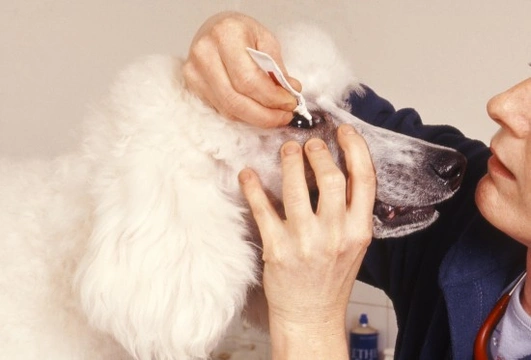
How to Administer Eye Drops or Eardrops to Your Dog
Many dog owners struggle with administering oral medications, but putting eye drops or eardrops in their dog is often more challenging. Over a dog's life, eye or ear treatments are frequently needed for conditions like conjunctivitis, eye injuries, ear mites, or excess wax. If you have returned from the vet with medication and feel unsure how to proceed, this comprehensive guide is here to help you confidently and safely administer eye or eardrops to your canine companion.
Staying Safe and Preparing to Administer Drops
Dealing with a dog’s eyes or ears requires care since these areas can be sensitive and painful. Even the gentlest dogs may react if they feel discomfort or fear, so it’s important to protect yourself. Have a second person available if possible, to help gently restrain your dog. If necessary, consider a muzzle for your safety, especially the first few times.
Gather all necessary items before starting — medication, cotton wool, towels, and treats. Ensure the drops or ointment are not cold to minimise discomfort. Creating a calm environment helps your dog remain relaxed throughout the process. Speak softly and use gentle but firm handling to build trust.
Administering Eye Drops to Your Dog
- Clean the Eye Area: Use a warm, damp cloth to gently remove any discharge or debris around the affected eye to help prevent further irritation.
- Position Yourself: Stand or sit behind your dog with their back to you. This angle prevents the dog from pulling away and helps you control the head.
- Open the Eye Gently: If you are right-handed, use your left hand to pull down the lower eyelid with your thumb and forefinger, creating a small pouch. Be careful not to scratch your dog.
- Apply the Drops: Hold the medication bottle in your right hand. Bring it to the side of the eye—avoiding the dog’s direct line of sight—and gently squeeze the prescribed number of drops onto the surface of the eye, without letting the applicator touch the eyeball.
- Using Ointment: If the medication is an ointment, squeeze a small amount onto the tip of the tube, then gently run a thin trail along the inside of the lower eyelid pouch, avoiding contact with the eye’s surface.
- Relax and Observe: Praise your dog warmly and give a treat. Watch your dog closely to ensure they don’t immediately paw or scratch the eye. Your vet might recommend using a protective buster collar to prevent interference while healing.
- Repeat if Necessary: Follow your vet's instructions for frequency and duration of the treatment, and be consistent to ensure full recovery.
Administering Eardrops to Your Dog
- Prepare the Medication: Shake the bottle gently. Have the cap off and keep cotton wool handy for any drips.
- Position Your Dog: For small dogs, sitting on your lap works well. Medium dogs can be positioned sitting before you on the floor, and large dogs are best sitting against a wall for stability.
- Expose the Ear Canal: Gently lift the ear flap straight up to straighten the ear canal. Dogs with upright ears will be easier to manage in this step.
- Apply the Drops: Drop the prescribed amount of medication into the ear canal, holding the dog’s ear open. If the applicator is safe, it may gently enter the canal, but avoid forcing it.
- Massage the Ear: After applying drops, gently massage the base of the ear to encourage the medication to move down into the canal and aid absorption.
- Expect Some Shaking: Dogs commonly shake their heads after treatment, flicking out some medication. This is normal and helps distribute the drops inside.
- Reward and Monitor: Offer praise and treats immediately afterwards. Prevent your dog from scratching their ears, again using buster collars if recommended by the vet.
Common Mistakes to Avoid and Tips for Success
- Never let the applicator tip touch your dog’s eye or ear canal to avoid injury or contamination.
- Avoid cold medication straight from the fridge; warm it gently in your hands before applying.
- Use calm, reassuring tones and patience to reduce stress and resistance.
- Do not try to force your dog if they are highly agitated; seek help from your vet for alternative methods.
- Consistent timing and positive reinforcement help build your dog’s cooperation over time.
Frequently Asked Question: Can You Give Dogs Calpol for Pain?
Quick Answer: Calpol (paracetamol) should never be given to dogs without veterinary advice as it can be toxic.
Calpol contains paracetamol which is safe for humans but harmful to dogs. If your dog is in pain or unwell, always consult a vet for appropriate medication and dosage rather than self-medicating. Incorrect medicines can lead to serious health complications or even be fatal.
Always prioritise professional guidance regarding your dog’s health and medication.
Final Thoughts
Administering eye drops or eardrops to your dog can be stressful for both owner and pet, but with preparation, patience, and gentle restraint, it becomes manageable. Always follow your vet’s instructions precisely and reward your dog generously to build a positive experience. Protect yourself, protect your dog, and remember that consistent, kind handling helps your furry friend heal comfortably and safely.
For those searching for a new dog, adopting or obtaining puppies from reputable breeders is vital for healthy, well-socialised pets.



